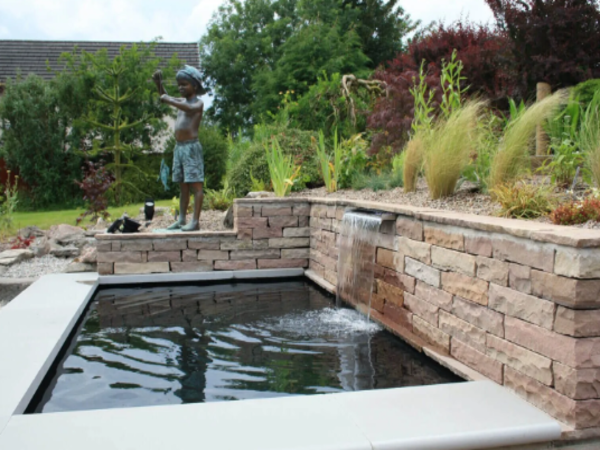Common Pond Problems Solved with Butyl Pond Liners

Your pond should bring peace, not problems. What starts as a serene feature can quickly turn into a headache — a small leak here, cloudy water there, and the constant worry as the water level drops.
The cause is often the liner. Poor-quality liners can’t cope with the unpredictable British weather, cracking and leaking as the ground shifts.
A butyl pond liner solves this. It withstands frost, rain, and roots, staying watertight and maintaining its shape. No more constant refills or wondering where the water went. Flexible, durable, and built to last, butyl ensures your pond stays full, clear, and low-maintenance for years to come. The real benefits begin once you switch to butyl.
Why Your Pond Keeps Leaking and How Butyl Fixes It
A leaking pond isn’t just an inconvenience; it drains your time, patience, and wallet. You top it up, only to watch the water level drop again. The cause often lies with the liner. Older PVC or budget rubber liners struggle with the constant expansion, contraction, and ground movement from unpredictable British weather. Over time, micro-tears and weak seams develop, allowing water to escape.
A butyl pond liner solves this. Made from durable, flexible synthetic rubber, it stretches, moulds to complex shapes, and remains watertight through frost, rain, and roots. For pond owners fed up with constant refills and repairs, switching to butyl means no more leaks, just peace of mind.
Common Reasons Your Pond Starts to Leak
Every pond has its breaking point — and it often begins with small oversights that spiral into bigger problems. Understanding what’s really going wrong helps you prevent future damage.
- Poor installation or groundwork – Many leaks start before the first drop of water is added. Sharp stones, roots, or uneven ground under the liner create pressure points that tear over time.
- Weather fatigue – Freeze-thaw cycles cause rigid liners to contract and expand, slowly forming cracks that widen with each winter.
- Ageing materials – Sunlight and time degrade PVC and thin rubber liners, leading to brittleness and surface splits.
- Soil movement – Ground settlement around the pond edge pulls on the liner and stretches seams until they fail.
- Root penetration – Trees and aquatic plants may find microscopic weaknesses, pushing through like nature’s slow-motion drill.
Each of these small failures turns your peaceful pond into an ongoing maintenance project — the very opposite of the calm you built it for.
How a Butyl Pond Liner Stops the Leaks for Good
Where cheaper liners resist, butyl adapts. That single difference is why it lasts decades longer. Butyl rubber’s high elasticity allows it to stretch up to 300 per cent of its length without tearing, which means it can flex with soil movement and temperature swings instead of cracking under stress.
Here’s how it quietly keeps your pond watertight:
- Unmatched elasticity and tensile strength – Moves with the ground, not against it.
- Vulcanised seams – Heat-bonded joins create a single continuous membrane, eliminating leak-prone welds.
- Exceptional weather resilience – Performs in sub-zero frost and summer heat alike without losing integrity.
- Root and puncture resistance – Dense composition shields against root systems and sharp debris.
- Long-term reliability – Typical lifespan exceeds 30 years with minimal maintenance.
The result is simple: fewer worries, fewer refills, and a pond that behaves exactly as intended — stable, full, and beautifully balanced.
When to Replace an Old Pond Liner with Butyl
Even the best liners have limits. If you’re constantly topping up water or patching the same spot every few months, replacement is more sensible than repair. Butyl not only fixes the leaks but also renews the entire pond ecosystem by preventing soil seepage and stabilising water chemistry.
You’ll know it’s time to replace your liner if:
- The water level keeps dropping despite every test and patch.
- Cracks, folds, or bleaching appear on the liner surface.
- The pond smells stale or develops persistent algae from ground seepage.
- The edges have pulled away from coping stones or walls.
Replacing your old liner with butyl isn’t an expense — it’s an investment in decades of clarity, stability, and calm. Once installed, you can stop fighting leaks and start enjoying your pond again, exactly as it was meant to be.
Beating the British Weather: Year-Round Pond Protection
British weather is famously unpredictable. One week, your pond shines under spring rain, the next it’s frozen or baking in a heatwave. These shifts challenge most pond liners, but butyl adapts with ease. Its flexibility allows it to expand and contract with temperature changes, maintaining a reliable seal through rain, frost, or sun — offering the steady resilience every British garden needs.
How Frost and Cold Weather Affect Pond Liners
Freezing temperatures are harsh on rigid liners. As water turns to ice, most liners stiffen and crack, leading to micro-tears that worsen each winter. Once the thaw comes, the damage is already done, and leaks start to appear. Butyl liners, however, stay supple in sub-zero temperatures. Their flexible structure absorbs pressure, preventing the cracks that ruin other materials. Butyl-lined ponds emerge from winter sealed and solid, ready for spring.
Surviving the Summer Heat and UV Exposure
Summer heat and UV rays can damage cheap liners, causing them to warp, fade, and crack. Over time, this leads to brittleness and water loss. A butyl pond liner is UV-stabilised, maintaining its flexibility and sleek appearance even in full sun or prolonged dry spells. It resists sunlight damage, ensuring it stays in top condition throughout the season.
Heavy Rain and Ground Movement: The Hidden Stress Test
Heavy rain, shifting soil, and rising water tables create uneven pressure on your pond liner. Most liners buckle or tear under this strain, leading to leaks and trapped debris. Butyl liners adapt to these changes, flexing with the ground without losing shape. Even in flood-prone areas, butyl stabilises the pond, protecting both the structure and the ecosystem.
Why Butyl Outlasts Every Season
Dealing with the unpredictable British weather is no easy task, but butyl liners handle it with ease. They won’t warp in heat, split in frost, or sag after a downpour. Their durability comes from their ability to flex and adapt, offering long-lasting performance that outlives other options. While others spend time repairing liners, butyl pond owners enjoy a steady, low-maintenance pond that stays full, clear, and reliable year after year.
Maintaining Clear and Healthy Pond Water
A healthy pond relies on clear water, thriving fish, and vibrant plants. When the liner degrades or isn’t installed correctly, algae blooms and poor filtration can quickly turn your pond into a swamp. Butyl pond liners prevent this. Their flexible, watertight seal keeps water stable, maintaining the perfect balance for both aquatic life and aesthetics. The result? A pond that stays clear, healthy, and low-maintenance year-round.
How Butyl Liners Prevent Algae Growth and Water Contamination
Algae thrive in nutrient-rich water, often caused by leaks from degrading liners. Butyl liners prevent contamination by forming a sealed barrier, stopping soil and organic matter from seeping into the pond. This keeps the water cleaner, reducing algae growth and the need for constant maintenance.
Easier Cleaning and Maintenance with Butyl Liners
Butyl liners simplify maintenance. Their smooth surface prevents the build-up of algae and debris, making cleaning easier. Unlike cheaper alternatives, they resist wear and tear from pressure washing, keeping maintenance time to a minimum.
Improving Filtration and Aeration with a Butyl Pond Liner
By maintaining a stable water level, butyl liners reduce strain on filtration systems, improving water clarity and health. They also help with aeration, preventing stagnation, and supporting fish and plant health.
Why Butyl Liners Enhance Pond Ecosystem Health
Stable water levels and a sealed environment support a healthy pond ecosystem. Butyl liners prevent contaminants from entering, keeping the water clean and ensuring fish and plants thrive without the risk of pollutants or algae overgrowth.
Eco-Friendly, Fish-Safe, and Built to Last
Butyl pond liners are non-toxic and environmentally friendly, ensuring no harmful chemicals leak into the water. Their durability reduces waste, as they last for decades without needing replacement, making them a sustainable choice for pond owners and the planet.
Is a Butyl Pond Liner Worth the Cost?
A butyl pond liner may seem like a significant upfront investment, but it quickly pays for itself. With its durability and ability to withstand harsh weather conditions, soil movement, and root intrusion, you’ll enjoy years of leak-free peace without the constant need for repairs. Unlike cheaper alternatives, which can crack, degrade, and require frequent replacements, a butyl liner offers long-term reliability and enhanced pond health. For those seeking quality and longevity, Butek Ponds offers top-of-the-range butyl liners that provide both value and peace of mind, ensuring your pond stays pristine for decades to come.
Final Thoughts
End the leaks, stop the waste, and finally enjoy a pond that stays full, clear, and calm. With a butyl pond liner from Butek Ponds, you’ll experience long-lasting peace of mind, knowing your pond is well-protected against the unpredictable British weather. No more frequent top-ups or costly repairs — just a beautifully maintained pond that thrives year after year.



